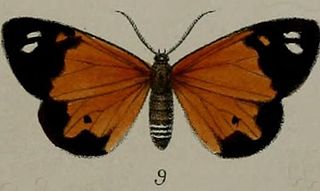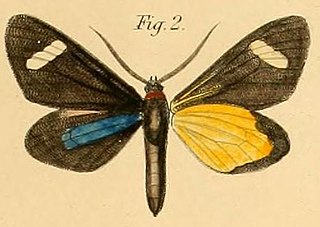
George Thomas Bethune-Baker was an English entomologist who specialised in Lepidoptera, especially those in the family Lycaenidae of butterflies.
Aneliopis is a genus of moths of the family Erebidae. The genus was erected by George Thomas Bethune-Baker in 1908. All the species are known from New Guinea.
Cheillophota is a genus of moths of the family Erebidae. The genus was defined by George Thomas Bethune-Baker in 1908. All of the species are found in New Guinea.
Insolentipalpus is a genus of moths of the family Erebidae. The genus was erected by George Thomas Bethune-Baker in 1908.
Focillodes is a genus of moths of the family Erebidae. The genus was erected by George Thomas Bethune-Baker in 1906.
Foveades is a genus of moths of the family Erebidae. The genus was erected by George Thomas Bethune-Baker in 1908.
Parilyrgis is a genus of moths of the family Erebidae. The genus was erected by George Thomas Bethune-Baker in 1908.

Penicillaria is a genus of moths of the family Euteliidae. The genus was erected by Achille Guenée in 1852.

Pilipectus is a genus of moths in the family Erebidae. The genus was erected by George Thomas Bethune-Baker in 1910.
Dasychiroides is a genus of moths in the subfamily Lymantriinae. The genus was erected by George Thomas Bethune-Baker in 1904.
Lymantriades is a genus of moths in the subfamily Lymantriinae. The genus was erected by George Thomas Bethune-Baker in 1911.
Neorgyia is a genus of moths in the subfamily Lymantriinae. The genus was erected by George Thomas Bethune-Baker in 1908.
Parakanchia is a genus of moths in the subfamily Lymantriinae. The genus was erected by George Thomas Bethune-Baker in 1908. The species are found in New Guinea.
Paraxena is a genus of moths in the subfamily Lymantriinae. The genus was erected by George Thomas Bethune-Baker in 1911. Both species are found in Angola.
Porthmeia is a genus of moths in the subfamily Lymantriinae erected by George Thomas Bethune-Baker in 1908. They are native to the island of New Guinea.

Pitthea is a genus of moths in the family Geometridae erected by Francis Walker in 1854.

Pitthea perspicua is a moth of the family Geometridae first described by Carl Linnaeus in his 1758 10th edition of Systema Naturae. It is found in Angola, Cameroon and the Democratic Republic of the Congo.
Metarbelodes obliqualinea is a moth in the family Cossidae described by George Thomas Bethune-Baker in 1909. It is found in Kenya and Uganda.

Cotana is a genus of moths in the family Eupterotidae.
Lasioceros is a genus of moths in the family Erebidae. The genus was erected by George Thomas Bethune-Baker in 1904.





